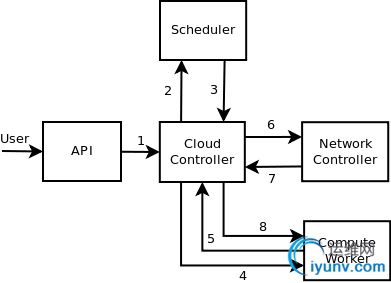|
|
综述
启动一个新的instance涉及到很多openstack nova里面的组件
- API server:处理客户端的请求,并且转发到cloud control
- Cloud control:处理compute节点,网络控制节点,API server和scheduler中间连接
- Scheduler:选择一个host去执行命令
- compute worker:启动和停止实例,附加和删除卷 等操作
- network controller:管理网络资源,分配固定IP,配置vlans

1.API server将消息发送到Cloud Controller
2. Authertication 保用户有权限,然后Cloud Controller将消息发送给Scheduler
3. Scheduler caste 一个消息给一个选择好的host要求他启动一个实例
4.compute worker(选择的那个host)获取到消息
5.6.7.8 compute worker需要一个固定的ip去启动一个实例,所以向network controller发送消息
下面我将详细说明一下:
API
1.可以在dashboard网页上面进行
2.可以用命令行 euca-add-keypair euca-run-instances
用户的请求发送到nova-api,有两种方式
第一种:通过openstack api (nova/api/servers.py 类 class Controller(object))create方法
def create(self, req, body):
""" Creates a new server for a given user """
if 'server' in body:
body['server']['key_name'] = self._get_key_name(req, body)
extra_values = None
extra_values, instances = self.helper.create_instance(
req, body, self.compute_api.create)
第二种:通过ec2 api (nova/api/cloud.py 中类 CloudController )
调用def run_instances(self, context, **kwargs):
...
(instances, resv_id) = self.compute_api.create(context,
instance_type=instance_types.get_instance_type_by_name(
kwargs.get('instance_type', None)),
...
最终调用的Compute API create():
- 查看这种类型的instance是否达到最大值
- 如果不存在安全组,就创建个
- 生成MAC地址和hostnames
- 给scheduler发送一个消息去运行这个实例
CAST
当然maxCount为1(默认值为1)的时候 调用RPC.cast方法向scheduler发送运行实例的消息

在openstack中通过RPC.cast来发送消息,消息的分发通过RabbitMQ。消息发送方(Compute API)往
topic exchange(scheduler topic)发送一个消息,消息消费者(Scheduler worker)从队列中获得消息,
cast调用不需要返回值。
[python] view plaincopyprint?
- def _schedule_run_instance(self,
- ...
- return rpc_method(context,
- FLAGS.scheduler_topic,
- {"method": "run_instance",
- "args": {"topic": FLAGS.compute_topic,
- "request_spec": request_spec,
- "admin_password": admin_password,
- "injected_files": injected_files,
- "requested_networks": requested_networks,
- "is_first_time": True,
- "filter_properties": filter_properties}})
Scheduler
scheduler接收到消息,然后通过设定的scheduler策略选择一个目的host,如:zone scheduler
选择一个主机在特定的可获取的zone上面。最后发送一个cast消息到特定的host上面
[python] view plaincopyprint?
- def cast_to_compute_host(context, host, method, update_db=True, **kwargs):
- """Cast request to a compute host queue"""
- if update_db:
- # fall back on the id if the uuid is not present
- instance_id = kwargs.get('instance_id', None)
- instance_uuid = kwargs.get('instance_uuid', instance_id)
- if instance_uuid is not None:
- now = utils.utcnow()
- db.instance_update(context, instance_uuid,
- {'host': host, 'scheduled_at': now})
- rpc.cast(context,
- db.queue_get_for(context, 'compute', host),
- {"method": method, "args": kwargs})
- LOG.debug(_("Casted '%(method)s' to compute '%(host)s'") % locals())
Compute
compute worker进程接收到消息执行方法(nova/compute/manager.py)
[python] view plaincopyprint?
- def _run_instance(self, context, instance_uuid,
- requested_networks=None,
- injected_files=[],
- admin_password=None,
- is_first_time=False,
- **kwargs):
- """Launch a new instance with specified options."""
- context = context.elevated()
- try:
- instance = self.db.instance_get_by_uuid(context, instance_uuid)
- self._check_instance_not_already_created(context, instance)
- image_meta = self._check_image_size(context, instance)
- self._start_building(context, instance)
- self._notify_about_instance_usage(instance, "create.start")
- network_info = self._allocate_network(context, instance,
- requested_networks)
- try:
- block_device_info = self._prep_block_device(context, instance)
- instance = self._spawn(context, instance, image_meta,
- network_info, block_device_info,
- injected_files, admin_password)
- ...
- 检查instance是否已经在运行
- 分配一个固定的ip地址
- 如果没有设置vlan和网桥,设置一下
- 最后通过虚拟化的driver spawn一个instance
network controller
network_info = self._allocate_network(context, instance,
requested_networks)
调用network的API的allocate_for_instance方法
[python] view plaincopyprint?
- def allocate_for_instance(self, context, instance, **kwargs):
- """Allocates all network structures for an instance.
- :returns: network info as from get_instance_nw_info() below
- """
- args = kwargs
- args['instance_id'] = instance['id']
- args['instance_uuid'] = instance['uuid']
- args['project_id'] = instance['project_id']
- args['host'] = instance['host']
- args['rxtx_factor'] = instance['instance_type']['rxtx_factor']
- nw_info = rpc.call(context, FLAGS.network_topic,
- {'method': 'allocate_for_instance',
- 'args': args})
RPC.call 与RPC.cast最大的不同 就是call方法需要一个response

Spawn instance
接下来我要说的就是虚拟化的driver spawn instance,我们这里使用的是libvirt(nova/virt/libvirt/lconnection.py)
[python] view plaincopyprint?
- def spawn(self, context, instance, image_meta, network_info,
- block_device_info=None):
- xml = self.to_xml(instance, network_info, image_meta, False,
- block_device_info=block_device_info)
- self.firewall_driver.setup_basic_filtering(instance, network_info)
- self.firewall_driver.prepare_instance_filter(instance, network_info)
- self._create_image(context, instance, xml, network_info=network_info,
- block_device_info=block_device_info)
- self._create_new_domain(xml)
- LOG.debug(_("Instance is running"), instance=instance)
- self._enable_hairpin(instance)
- self.firewall_driver.apply_instance_filter(instance, network_info)
- def _wait_for_boot():
- """Called at an interval until the VM is running."""
- try:
- state = self.get_info(instance)['state']
- except exception.NotFound:
- LOG.error(_("During reboot, instance disappeared."),
- instance=instance)
- raise utils.LoopingCallDone
- if state == power_state.RUNNING:
- LOG.info(_("Instance spawned successfully."),
- instance=instance)
- raise utils.LoopingCallDone
- timer = utils.LoopingCall(_wait_for_boot)
- return timer.start(interval=0.5, now=True)
- 通过libvirt xml文件,然后根据xml文件生成instance
- 准备network filter,默认的fierwall driver是iptables
- image的创建(详细情况以后再介绍)
def _create_image(self, context, instance, libvirt_xml, suffix='',
disk_images=None, network_info=None,
block_device_info=None):
...
- 最后虚拟化driver的spawn()方法中调用driver 的creatXML()
|
|